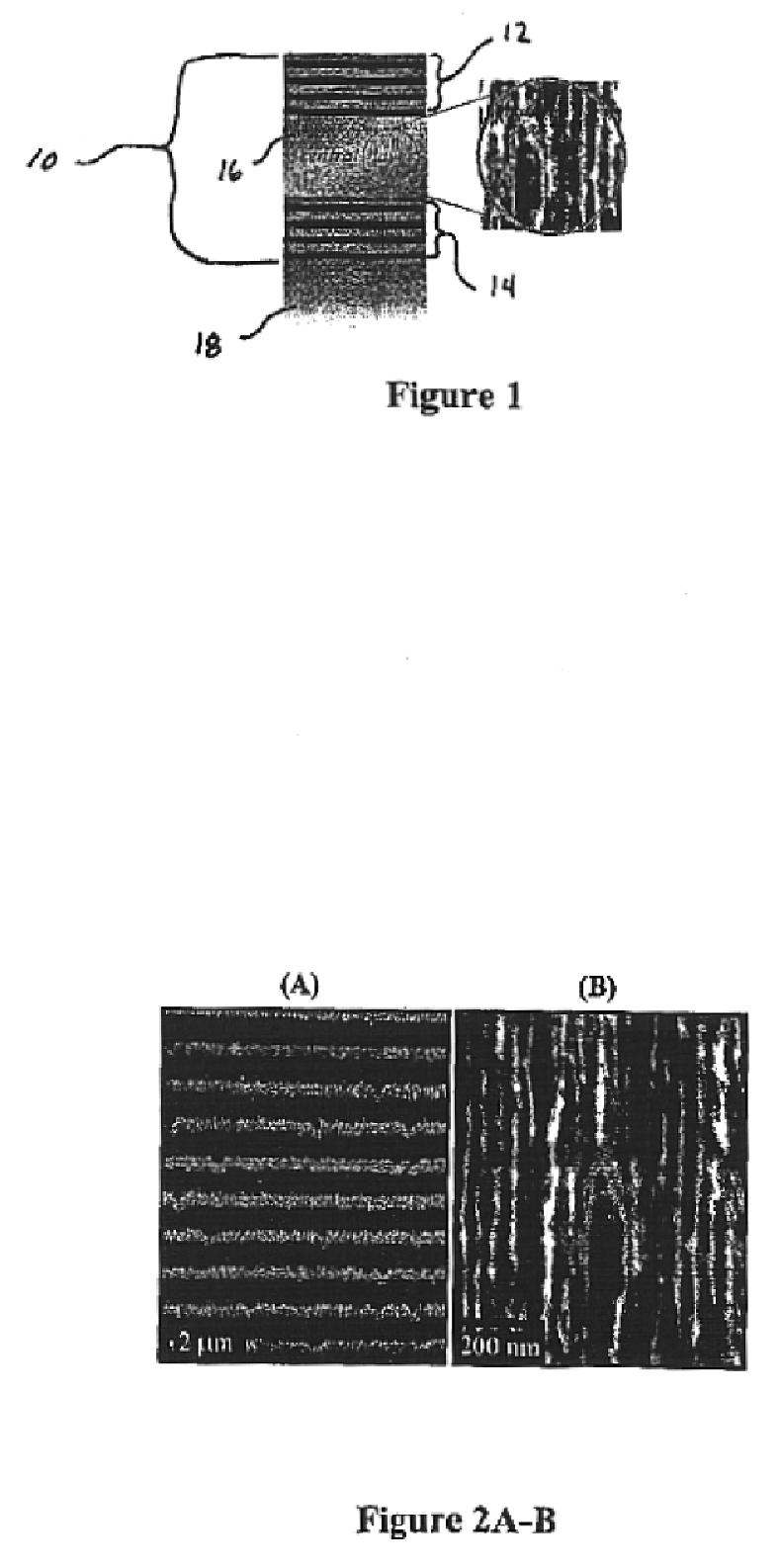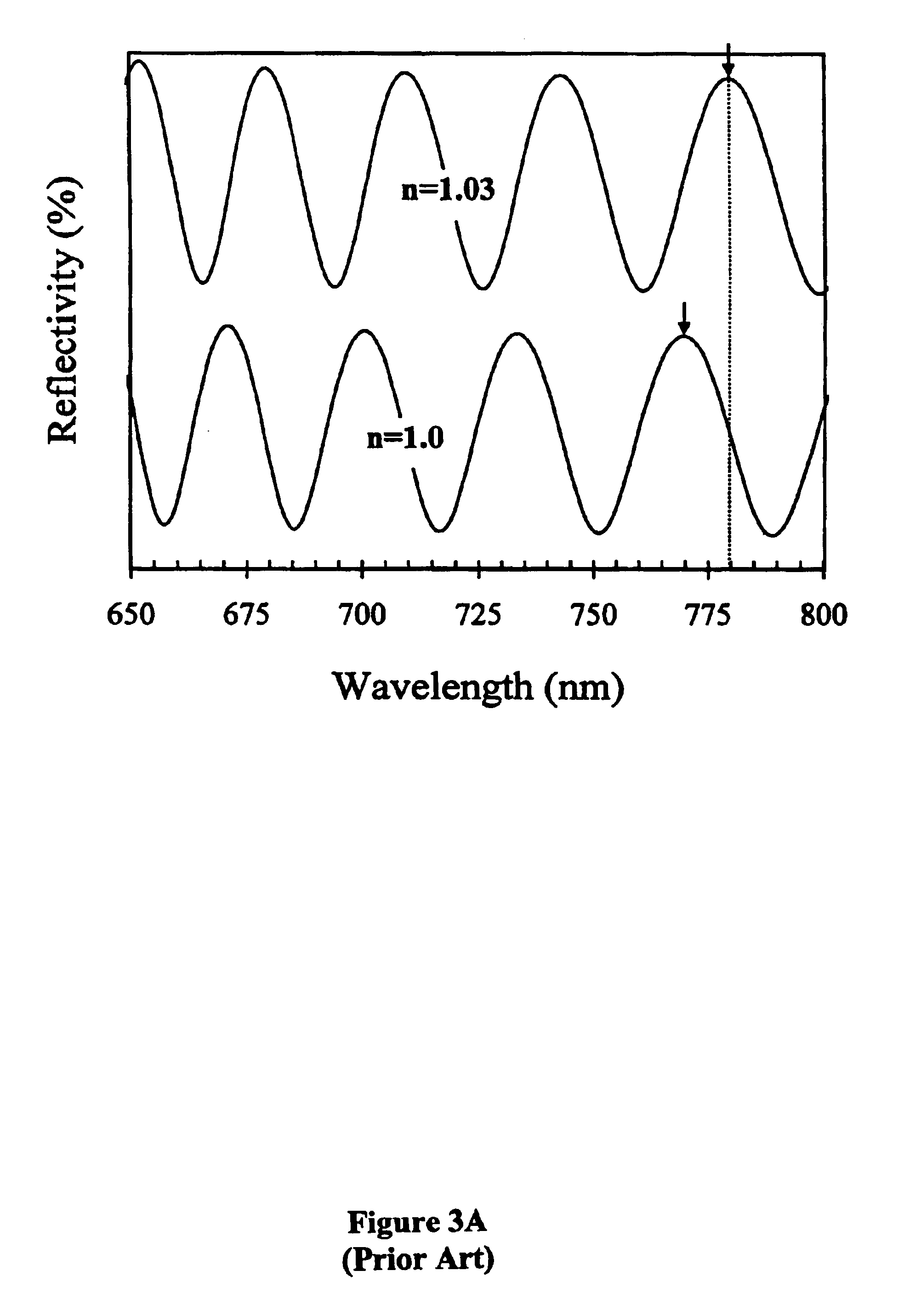Microcavity biosensor and uses thereof
- Summary
- Abstract
- Description
- Claims
- Application Information
AI Technical Summary
Benefits of technology
Problems solved by technology
Method used
Image
Examples
example 1
Synthesis of Porous Silicon Microcavity
[0069]Porous silicon samples are produced electrochemically with computer control. This allows precise control of the current density and switching times necessary in the fabrication of multilayer structures and assures maximum reproducibility.
[0070]The multilayer structure is created using a periodic current density square pulse during the electrochemical dissolution process. The dissolution of the silicon atoms is mainly restricted to a region next to the substrate, therefore the porous layer first formed remains intact throughout subsequent etching. By varying the current density during the etch, it is possible to change the porosity at the silicon / electrolyte interface.
[0071]Porous silicon multilayer mirrors and microcavity resonators are electrochemically formed by anodic etching in a hydrofluoric electrolyte. Table 1 below details the experimental conditions used in the formation of porous silicon 10 multilayer mirrors.
[0072]
TABLE 1Porous...
example 2
Preparation of DNA Binding Sensor
[0076]Using a porous silicon microcavity structure prepared according to Example 1, a DNA binding sensor was prepared by attaching a DNA probe to the porous silicon microcavity.
[0077]Silanization of the porous silicon microcavity was achieved by its incubation in a 5% solution of 3-glycidoxypropyl trimethoxy silane in water / ethanol (1:1) for 14 hours. Silane solution was then drained off, and the silanized device washing repeatedly with glass-distilled, deionized water.
[0078]The silanized porous silicon microcavity structures were exposed to a 24-mer DNA molecule according to SEQ ID No: I as follows:
tagctatgga attcctcgta ggca 24
[0079]The 24-mer DNA molecules covalently bond to the silanized surface, where they become immobilized. The nucleophilic amine group, attached at the 3′ end of the DNA strand, attacks the epoxide ring of the silane. The porous silicon—DNA samples are initially placed in a constant temperature water bath where they are incubate...
example 3
Binding Complementary DNA with DNA Binding Sensor
[0081]A DNA binding sensor of Example 2 was used to bind a strand of DNA complementary to the probe. The complementary 22-mer DNA molecule has a nucleotide sequence according to SEQ ID No: 2 as follows:
gcctacgagg aattccatag ct 22
[0082]The sensing probes of single stranded DNA molecules seek out only their complement in a complex mixture of DNA containing a large number of other nucleic acid molecules. Binding is allowed to proceed for 1 hour at room temperature in aqueous solution. Binding of the complementary DNA molecule was confirmed using Fourier Transform Infrared Spectroscopy.
[0083]The effect of DNA—cDNA binding is exemplified in FIG. 4A. By taking the difference between the photoluminescence spectra before and after DNA-cDNA hybridization, a 7 nm red-shift is observed, suggesting that the change in refractive index increased by 0.03. This change is best noted as a change in optical thickness, since a slight increase in thicknes...
PUM
| Property | Measurement | Unit |
|---|---|---|
| Pore size | aaaaa | aaaaa |
| Pore size | aaaaa | aaaaa |
| Pore size | aaaaa | aaaaa |
Abstract
Description
Claims
Application Information
 Login to View More
Login to View More - R&D
- Intellectual Property
- Life Sciences
- Materials
- Tech Scout
- Unparalleled Data Quality
- Higher Quality Content
- 60% Fewer Hallucinations
Browse by: Latest US Patents, China's latest patents, Technical Efficacy Thesaurus, Application Domain, Technology Topic, Popular Technical Reports.
© 2025 PatSnap. All rights reserved.Legal|Privacy policy|Modern Slavery Act Transparency Statement|Sitemap|About US| Contact US: help@patsnap.com



